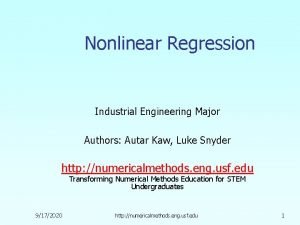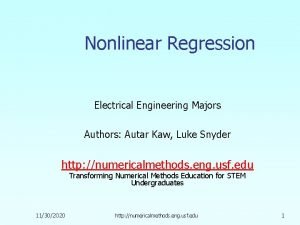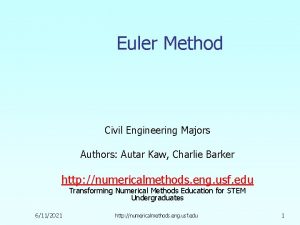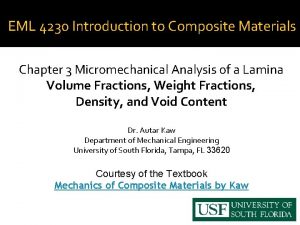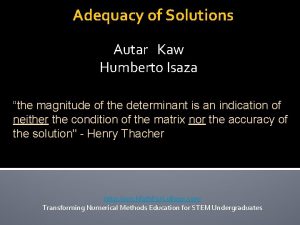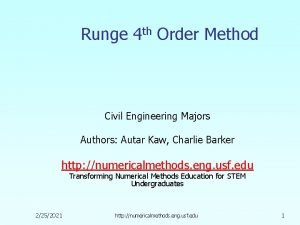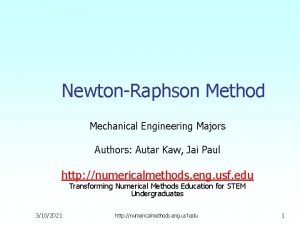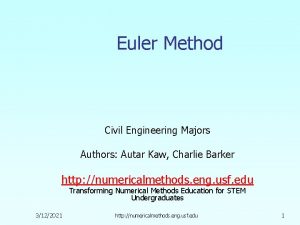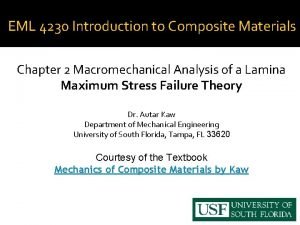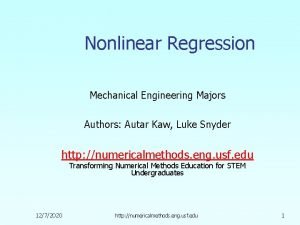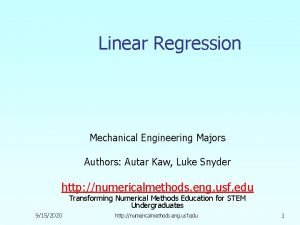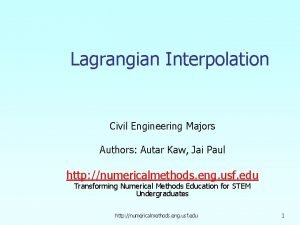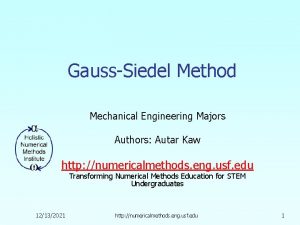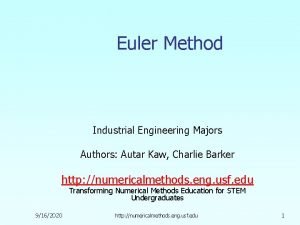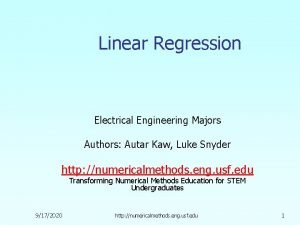Lagrangian Interpolation Mechanical Engineering Majors Authors Autar Kaw






















- Slides: 22

Lagrangian Interpolation Mechanical Engineering Majors Authors: Autar Kaw, Jai Paul http: //numericalmethods. eng. usf. edu Transforming Numerical Methods Education for STEM Undergraduates http: //numericalmethods. eng. usf. edu 1

Lagrange Method of Interpolation http: //numericalmethods. eng. usf. edu

What is Interpolation ? Given (x 0, y 0), (x 1, y 1), …… (xn, yn), find the value of ‘y’ at a value of ‘x’ that is not given. 3 lmethods. eng. usf. edu http: //numerica

Interpolants Polynomials are the most common choice of interpolants because they are easy to: Evaluate Differentiate, and Integrate. 4 lmethods. eng. usf. edu http: //numerica

Lagrangian Interpolation 5 lmethods. eng. usf. edu http: //numerica

Example A trunnion is cooled 80°F to − 108°F. Given below is the table of the coefficient of thermal expansion vs. temperature. Determine the value of the coefficient of thermal expansion at T=− 14°F using the Lagrangian method for linear interpolation. 6 Temperature (o. F) Thermal Expansion Coefficient (in/in/o. F) 80 6. 47 × 10− 6 0 6. 00 × 10− 6 − 60 5. 58 × 10− 6 − 160 4. 72 × 10− 6 − 260 3. 58 × 10− 6 − 340 2. 45 × 10− 6 lmethods. eng. usf. edu http: //numerica

Linear Interpolation 7 lmethods. eng. usf. edu http: //numerica

Linear Interpolation (contd) 8 lmethods. eng. usf. edu http: //numerica

Quadratic Interpolation 9 lmethods. eng. usf. edu http: //numerica

Example A trunnion is cooled 80°F to − 108°F. Given below is the table of the coefficient of thermal expansion vs. temperature. Determine the value of the coefficient of thermal expansion at T=− 14°F using the Lagrangian method for quadratic interpolation. 10 Temperature (o. F) Thermal Expansion Coefficient (in/in/o. F) 80 6. 47 × 10− 6 0 6. 00 × 10− 6 − 60 5. 58 × 10− 6 − 160 4. 72 × 10− 6 − 260 3. 58 × 10− 6 − 340 2. 45 × 10− 6 lmethods. eng. usf. edu http: //numerica

Quadratic Interpolation (contd) 11 lmethods. eng. usf. edu http: //numerica

Quadratic Interpolation (contd) 12 lmethods. eng. usf. edu http: //numerica

Cubic Interpolation 13 lmethods. eng. usf. edu http: //numerica

Example A trunnion is cooled 80°F to − 108°F. Given below is the table of the coefficient of thermal expansion vs. temperature. Determine the value of the coefficient of thermal expansion at T=− 14°F using the Lagrangian method for cubic interpolation. 14 Temperature (o. F) Thermal Expansion Coefficient (in/in/o. F) 80 6. 47 × 10− 6 0 6. 00 × 10− 6 − 60 5. 58 × 10− 6 − 160 4. 72 × 10− 6 − 260 3. 58 × 10− 6 − 340 2. 45 × 10− 6 lmethods. eng. usf. edu http: //numerica

Cubic Interpolation (contd) 15 lmethods. eng. usf. edu http: //numerica

Cubic Interpolation (contd) 16 lmethods. eng. usf. edu http: //numerica

Comparison Table 17 lmethods. eng. usf. edu http: //numerica

Reduction in Diameter The actual reduction in diameter is given by where Tr = room temperature (°F) Tf = temperature of cooling medium (°F) Since Tr = 80 °F and Tr = − 108 °F, Find out the percentage difference in the reduction in the diameter by the above integral formula and the result using thermal expansion coefficient from the cubic interpolation. 18 lmethods. eng. usf. edu http: //numerica

Reduction in Diameter We know from interpolation that Therefore, 19 lmethods. eng. usf. edu http: //numerica

Reduction in diameter Using the average value for the coefficient of thermal expansion from cubic interpolation The percentage difference would be 20 lmethods. eng. usf. edu http: //numerica

Additional Resources For all resources on this topic such as digital audiovisual lectures, primers, textbook chapters, multiple-choice tests, worksheets in MATLAB, MATHEMATICA, Math. Cad and MAPLE, blogs, related physical problems, please visit http: //numericalmethods. eng. usf. edu/topics/lagrange_ method. html

THE END http: //numericalmethods. eng. usf. edu


